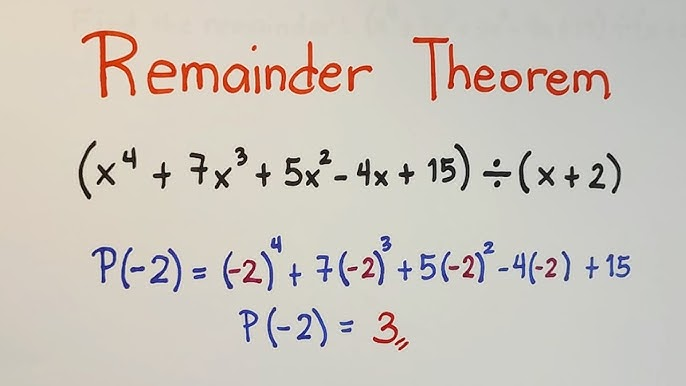Math: Polynomial & Rational Functions
1/8
There's no tags or description
Looks like no tags are added yet.
Name | Mastery | Learn | Test | Matching | Spaced |
|---|
No study sessions yet.
9 Terms
Factor Theorem
If something is a factor of a polynomial, then when substituted or divided, the remainder will be zero. Set the possible factor to zero and solve for x, then divide the polynomial by that number. If the remainder is zero, it is a factor. You can plug the “a” value into the polynomial, and if it is equal to zero, then it is a factor.
Remainder Theorem
(x-a): remainder is p(a). Useful for Calculating remainders: It allows you to calculate the remainder without performing long division. Determining factors: You can use the remainder theorem to determine if a linear expression is a factor of a polynomial. If the remainder is zero, then the expression is a factor.

Rational Root Theorem
P/Q=factors of the last term/factors of the first term. Plug in possible factors until one equals zero and divide the polynomial by the factor to find the other factors.
Vertical Asymptote
To find the vertical asymptotes of a rational function, set the denominator equal to zero and solve for the input variable. All the zeroes of the denominator are vertical asymptotes, except when the same zero occurs in the numerator.
Horizontal Asymptote
Horizontal asymptotes
The rules for horizontal asymptotes depend on the degrees of the numerator and denominator of a rational function:
If the degree of the numerator is less than the degree of the denominator, the horizontal asymptote is 𝑦=0
If the degree of the numerator is equal to the degree of the denominator, the horizontal asymptote is y=c, where c is the ratio of the leading terms or their coefficients
If the degree of the numerator is greater than the degree of the denominator, there is no horizontal asymptote
Slant Asymptote
A slant asymptote occurs when the degree of the numerator is one more than the degree of the denominator. To find the slant asymptote, divide the rational function and ignore the remainder.
Rational Function x-int
Set numerator to zero:
To find x-intercepts, take the rational function and set its numerator equal to zero.
Solve for x:
Once the numerator is set to zero, solve the equation for x to find the x-intercept(s)
Holes
To solve for holes in a rational function, factor the numerator and denominator, cancel out any common factors, then set the canceled factor equal to zero and solve for x; this value of x will represent the location of the hole in the graph of the function. Finding the x-coordinate: To find the x-coordinate of the hole, set the canceled factor equal to zero and solve for x. Finding the y-coordinate: To find the y-coordinate of the hole, substitute the x-value you found into the simplified function.
Fundamental Theorem of Algebra
Every one variable polynomial of degree ”n” has exactly “n” complex roots. If a function is odd, it can have at least 1 real roots, will have opposite end behavior, and will cut the x-axis at least once. If it is even, it can have 0 and does not need to cross x-axis. If it is odd, it could have 0 complex roots. If it is even, it must have an even number, minimum of 2.